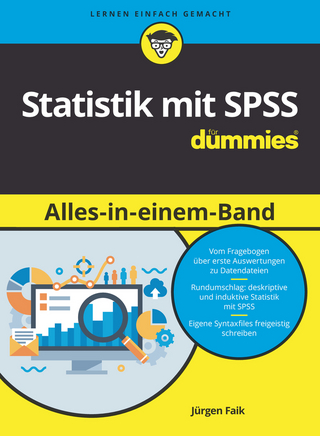
An Introductory Guide to SPSS® for Windows®
SAGE Publications Inc (Verlag)
978-1-4129-0415-5 (ISBN)
Do you need to conduct data analysis with SPSS but are unfamiliar with the software? This user-friendly book—a SAGE bestseller—helps you become proficient in SPSS by teaching you the fundamentals of SPSS. An Introductory Guide to SPSS® for Windows®, Second Edition develops SPSS skills using sample programs illustrating how to conduct the analyses typically covered in an introductory statistics course. Throughout the book, data are analyzed and SPSS output are interpreted in the context of research questions. Boldface text is used to indicate operations or choices the reader will need to make when running SPSS. Exercises are also included, with solutions provided in the appendix.
"I want to commend the author for including a chapter on using the SPSS manuals. I would not have thought of this addition, and the information helps the reader go on to learn the more complex components of SPSS."
—Laura Myers, University of Georgia
This Second Edition has been updated to SPSS Version 12.0, although its approach makes it useful for readers running other versions. Each chapter in this updated text includes a statement of its purpose and goal, as well as a chapter glossary. The updated text includes new SPSS features, including how to recode data using the Visual Bander and how to read text data using the Text Import Wizard. Author Eric L. Einspruch thoroughly covers critical basic skills:
• How to create data sets by defining and coding data, using a codebook, and entering data
• How to run SPSS and work with different SPSS files
• How to manipulate data by recoding values, computing values, and selecting subsets of cases to include in an analysis
• How to manage data files by reading data that have been entered using other software, appending files, and merging files
• How to analyze data using SPSS pull-down menus
• How to analyze data using programs written in SPSS syntax
This outstanding book concludes with a discussion of how to get help in SPSS, suggestions on how to make the most of SPSS manuals, and directions for taking the next steps toward software mastery.
Eric L. Einspruch is a Senior Research Associate and Project Director at RMC Research Corporation in Portland, Oregon. He received his B.A. with an emphasis in human ecology from The Evergreen State College in Olympia, Washington and his M.S.Ed. in counseling psychology and his Ph.D. in educational research and evaluation from the University of Miami in Coral Gables, Florida. Much of his experience with large-scale data analysis was acquired while working in the Office of Institutional Research at Miami-Dade Community College. He has taught courses in statistical methods and in computer applications in educational research. He is currently involved in the evaluation of school-based and community-based social service programs. His publications have appeared in the Florida Journal of Educational Research, International Journal of Early Childhood, Journal of Counseling Psychology, Journal of Drug Education, Journal of Primary Prevention, Psychotherapy in Private Practice, and Reaching Today’s Youth. He is active in the Oregon Program Evaluators Network, a local affiliate of the American Evaluation Association, serving as charter Secretary in 1999 and 2000 and as President in 2003.
Acknowledgments
1. Introduction
2. Creating Datasets
Defining Data Files and Coding Data
Coding Missing Data
Entering Data
3. Running SPSS
SPSS Files
Getting Started: Entering the Wintergreen Data
Data Analysis
Drawing Charts
Designating a Window
Exercise One
4. Data Manipulation
Changing the Coding Scheme Using Recode
Changing the Coding Scheme Using Visual Bander
Computing Data Values
Selecting Records From a Dataset
Listing Cases
Exercise Two
Exercise Three
5. Managing Data Files
Reading ASCII Data
Importing Files From Other Software Packages
Merging Data Files: Adding Cases
Merging Data Files: Adding Variables
Exercise Four
Exercise Five
6. Using SPSS to Perform Statistical Analyses
Frequency Distributions
Correlation
Crosstabulation and Chi-Square
Testing Hypotheses About Two Means (t-Test)
Comparing Several Means (ANOVA): One Group
Comparing Several Means (ANOVA): Two or More Groups
Simple Regression
Using Nonparametric Statistics
Exercise Six
Exercise Seven
Exercise Eight
Exercise Nine
Exercise Ten
7. Using the SPSS Syntax Window
Using the Syntax Window
The Structure of Basic SPSS Programs
Debugging SPSS Programs
Inserting Comments About the Program
Reading Data
Merging Data
Manipulating the Data
Sample SPSS Program
Correlation
Crosstabulation
t-Test for Independent Samples
Regression
Nonparametric Statistics
8. Next Steps
Help Is Nearby
Getting the Most From the SPSS Manuals
User′s Guide
Syntax Reference Guide
Next Steps
Statistics Coach
Pivot Tables
Utilities
Production and Scripting Facilities
World Wide Web Home Page
9. Conclusion
Appendix A: Solutions to Exercises
Appendix B: Tips
References
Index
About the Author
| Erscheint lt. Verlag | 26.5.2005 |
|---|---|
| Verlagsort | Thousand Oaks |
| Sprache | englisch |
| Maße | 152 x 228 mm |
| Gewicht | 250 g |
| Themenwelt | Mathematik / Informatik ► Mathematik ► Computerprogramme / Computeralgebra |
| Sozialwissenschaften ► Soziologie ► Empirische Sozialforschung | |
| ISBN-10 | 1-4129-0415-3 / 1412904153 |
| ISBN-13 | 978-1-4129-0415-5 / 9781412904155 |
| Zustand | Neuware |
| Haben Sie eine Frage zum Produkt? |
aus dem Bereich


